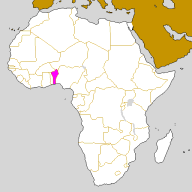Benin History
1 The Kingdom of Dahomey2 Dahomey's Colonization
3 Dahomey and its Independence
4 The Years of Revolution
5 New Benin and Political Evolution
6 Benin Rebirth
 |
 |
The Kingdom of Dahomey was founded at the beginning of the 17th century. The kingdom gradually spread its domination over most of the neighbouring regions. King Agadja, who at the beginning of the 18th century established a female army corps, known as “Amazones”, took the control of Allada and Ouidah, becoming in this way a real supplier of slaves to the Europeans. After King Agadja’s death, Dahomey was dominated for some time by the kingdom of Oyo, but was reinstated by King Guézo (who reigned from 1818 till 1858). Then about 1850 the French started to arrive. The last king of Abomey, King Béhanzin, resisted colonisation for a few years but without great success. Thus Dahomey became a French colony.
2 Dahomey's Colonization
In 1851 France signed a friendship and trade treaty with Porto-Novo’s King, who was a protégé of King Glèlè (who reigned from 1858 to 1889). In 1861 British forces acquired the city of Lagos. The French and the British thus signed two treaties, one in 1868 and the other in 1878, which ended in the capture of Cotonou by French forces. King Béhanzin then tried to regain Cotonou, an essential city for continuation of the slave trade. Defeated in December 1892, despite fierce resistance, the Kingdom of Abomey was made a French protectorate. In 1899 Dahomey was incorporated into French West Africa, its borders being defined by an Anglo-German treaty, they being respectively the colonisers of the East and the West . At the end of World War I, the Eastern part of the German colony Togo, was placed under French mandate. Dahomey joined the « Free French » during World War II, and in 1946 it became one of the overseas French territories. The country proclaimed its independence in 1960.
3 Dahomey and its Independence
Benin’s political evolution was particularly eventful for several years. The first president, Hubert Maga, was deposed in 1963 by an army major. In 1970 a commission of three presidents came to the power and abolished the constitution. The members, which included president Maga, took turns at the presidency. Maga became the first president , followed by Justin Ahomadégbé in 1972.
4 The Years of Revolution
On the 26th October 1972, Major Mathieu Kérékou overthrew the government in a military putch. Dahomey took the name of Benin on 30th November 1975. Marxism-Leninism was adopted as a political and economical guide, but was later abandoned in 1989. Political transformation hich arrived in 1990 with at the formation of a transitional government which aimed at a multiparty democracy.
5 New Benin and Political Evolution
In February 1996, more than 80 political parties were officially recognized. The political evolution of Benin, over the last thirty years, has been particularly eventful. Many times the army came out and imposed itself as the only political force on the national chessboard, even so failing to provide stability, reinforce institutions, make the administration efficient, or fulfil Beninese hopes. From 1975 to 1989, the military-marxist regime shelved the national economy. A national vital forces conference aimed to wake up Benin and become a presidential pluralist democracy. From 19th to 28th February 1990, 488 delegates representing 51 political viewpoints regional associations for development, faiths and religious associations, professional groups, and also Beninese abroad, reflected on national matters and proclaimed the sovereignty of the national vital forces conference. They made executive conference decisions. During a transitional period of 12 months from 12th March 1990, the Conference elected Nicéphore Soglo as Prime Minister, voted by referendum for a new constitution, and established a calendar for legislative and presidential elections in order to set a new regime. Thus, on 24th March 1991, Nicéphore Soglo was elected as president with a five-year mandate. In February of the same year, the National Assembly elected 64 delegates with universal direct voting for a four-year mandate. A new page in Benin history had been turned.
6 Benin Rebirth
Coinciding with the end of the Cold War and the Fall of The Berlin Wall, the peaceful democratic transition of Benin gained ground in Africa, to the point that Senegalese president Abdou Diouf described Benin as a country « where democracy has reborn in Africa ». And with good reason: liberalisation and modernisation of the economy, the restoration of macro economic equilibrium, the stabilization and upturn in the banking system, facilities rehabilitation and a good sponsor response , have in four-year period raised Benin to the rank of a model country for economic and social performance. Held up as an example and particularly appreciated by its development partners, Benin was chosen to host the 6th Summit of the Heads of State of the French-speaking-communities. France and Canada. The president of the Republic of Benin is the head of state and supreme commander of the army. He is elected by universal suffrage for a five-year mandate, renewable once. Nicéphore Dieudonné Soglo is the first president elected in a democratic manner in Benin. He was defeated the 4th April 1996 by Mathieu Kérékou, a former dictator who ran Benin for 18 years.
